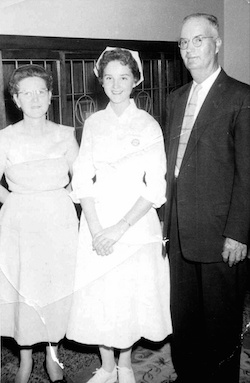
When Elaine O'Brien, née Weidenfeller, graduated from the Seton School of Nursing in 1960 (seen here with her parents), she was unaware of the racial discrimination in hospitals that Medicare ended five years later.
I wonder how many folks realize that Medicare brought about the end of racial segregation in hospitals. I didn’t know because I was asleep in college when Medicare was signed into law. Heck, I didn’t even realize hospitals were segregated until a few years ago when a colleague made it real to me with a story from her nursing school days.
Elaine O’Brien graduated from the Seton School of Nursing in 1960, and for the pediatric rotation, her class was sent to the public hospital in New Orleans, Charity Hospital, for three months.
When the girls arrived at Charity, Elaine was shocked to find that the children were divided between “white wards” and “colored wards” and even more horrified to find that the nursing students from all over the Deep South refused to care for the black children. “The Austin girls were happy to care for them,” she said. “They were darling, and we loved them.”
Elaine never saw this coming. She grew up in Fredericksburg, population 3,000 when she was born, now around 11,000. There were only two black people in town: Dr. and Mrs. Phillips. He was the veterinarian and she, the librarian. The town very much respected, admired and embraced them. A testament to the enlightened environment is that their son Paul Phillips, MD, recently returned to Fredericksburg to practice orthopedics.
When she arrived at Charity, she was totally unfamiliar with health care’s sorry and disgraceful history of discrimination. The original red-brick Seton hospital on 26th Street where Elaine studied nursing was an anomaly in that it was integrated. Fully integrated hospitals were rare, even in the North.
Most U.S. hospitals were either “all-black” or “mixed-race,” which had the aforementioned “white wards” and “colored wards.” The latter were stuck in a basement, attic space, wing or separate building usually connected to the main hospital with an exposed corridor. Whites could recuperate in private rooms or corridors with new beds, air-conditioning, fresh paint, better staffing and longer family visiting hours. White physicians could care for patients in any bed — ward or private, black or white. African-American physicians, if granted admitting privileges, were restricted to the black wards.
We remember the July 30, 1965 signing of Medicare into law as the smooth establishment of a popular program. But that’s not at all how it went down. A key element of the law was that hospitals would have to become integrated for certification to receive Medicare funds. After passage, but before implementation, the program was nearly destroyed by hospitals threatening to boycott it.
But President Lyndon Johnson allowed no compromise and set up a battle council. He had Vice President Hubert Humphrey telephone mayors to pressure resistant hospitals. Importantly, he sent hundreds of inspectors to ensure participating hospitals were integrated. In the final weeks before Medicare’s beginning, the hospitals integrated rather than lose federal dollars. Thus began Medicare fifty years ago.
Elaine and I worked together in the neonatal intensive care unit at the Seton Medical Center on 38th Street most of our careers. More accurately, Elaine worked circles around all of us. When she told me the shameful story of overt racism she encountered many decades previous, it was still as fresh in her mind as if it happened the day before. It was a loss-of-innocence moment for her and appalling to me.
In no small part because of Medicare, we were able to spend our nursing careers in a place where every baby — black, brown or white — was the center of the universe.

 Austin, Texas
Austin, Texas